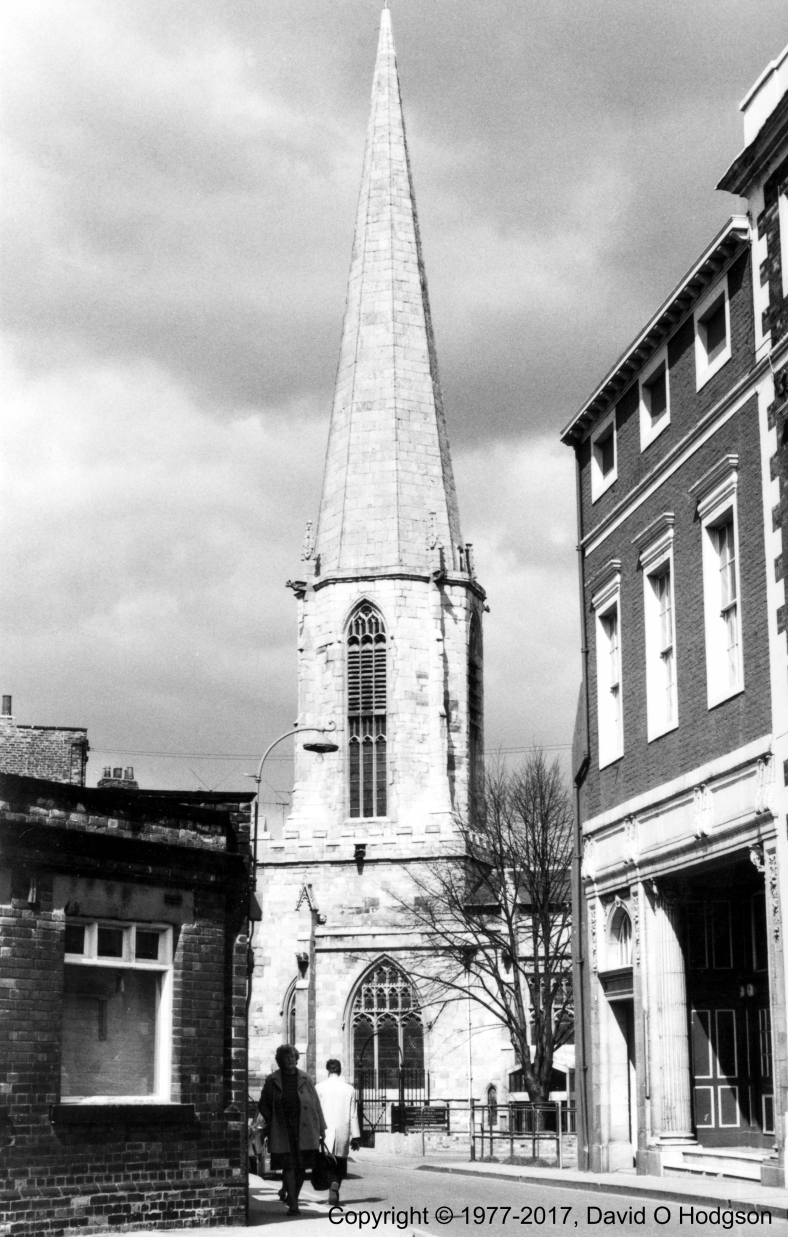 I took the photo above, showing the church of St. Mary’s, Castlegate, York, during 1977. It was taken with Ilford FP4 film.
I took the photo above, showing the church of St. Mary’s, Castlegate, York, during 1977. It was taken with Ilford FP4 film.
At that time, most of my photographs were taken with monochrome 35mm film, which I developed and printed myself. Most of them were taken for record purposes, without any serious attempt to produce high-quality or artistic results. Nonetheless, the photo above turned out to be one of the best, in terms of composition and tonal balance.
Thinking back now on those days, in this age of ubiquitous digital photography, the concerns and challenges of film photography seem like part of an alien world. Everything seemed more complex, and it was also quite an expensive pursuit. There was no instant feedback; you had to wait for a photograph to be developed before you could assess the quality, which led to much waste, increasing the effective cost of the photographs that ended up being usable.
The Accidental Photographer
During the 1960s my father became a keen amateur photographer. He owned several cameras, plus a complete suite of darkroom equipment, including two enlargers. He was a member of the Scarborough Camera Club, and regularly exhibited his work at their shows. He used a variety of film formats, from 35mm monochrome, through to much larger negative formats in color or monochrome. He developed and printed monochrome film images himself, and although he experimented with developing and printing color images, he found that too complex and expensive to be worthwhile.
By the mid-1970s, my father’s health had deteriorated to the point that he no longer took an active interest in photography, so I found myself “inheriting” all his equipment. At the same time, I was developing an interest in local history, and was soon to begin my Advanced-Level Art study of architecture, so I was able to make perfect use of his equipment. Nonetheless, I had to make tradeoffs regarding cost and quality.
Predicting Digital Photography
In 1983, during my final year as an undergraduate electronic engineering student at Imperial College, London, we were required to prepare a group report on a relevant topic. My group chose to write a report on possible future developments in telecommunications.
One of the future technologies that we predicted was the development of digital cameras. Our prediction wasn’t really too much of a stretch, because digital framestores already existed, and low-resolution framestores were already used in computer monitors.
It took some time for digital image technology to eclipse film, but for all practical purposes we have now reached that point. Perhaps surprisingly, given my professional contributions to digital video technology, even when digital cameras first became available, I continued to use 35mm film (albeit sometimes output to Kodak Photo CD format), on the grounds that digital images were not of comparable quality.
Eventually, however, the digital technology caught up, and the image quality now available even from some phone cameras now surpasses that possible with 35mm film. (Using 35mm film involved so many variables that the ideally-achievable quality was almost never achieved in reality.)
Return to Castlegate
Some 22 years later, in 1999, my wife and I stayed in the Stakis Hotel (now the Hilton) in York, which was constructed later on the site of the brick building in the left foreground of the 1977 photo above.
The present-day Google Streetview version of the same York location can be seen here.
“Such a Vision of the Street”
In his beautiful poem Preludes, written more than a century ago, T S Eliot masterfully evoked the dingy ambience of a rainy urban street.
I was also inspired by night-time photographs of urban settings by other photographers, and I realized that my monochrome film was fast enough to be used at night, if the camera was on a tripod.
One rainy evening, I took my father’s heavy wooden tripod with me to the Odeon roundabout in Scarborough, next to the railway station, and set it up to take some experimental shots. Not all of the photos came out well, but some were quite effective.
The photo below shows the entrance to the Odeon Cinema (now the Stephen Joseph Theatre), when passengers had just alighted from a United 101 service bus. The reflection of light from the wet road surface was particularly effective in this shot.

Scarborough Odeon at night, 1977
You can see that the Odeon was showing the movie The Pink Panther Strikes Again, which, on another night, I did actually go to see at that cinema.
In those photographs, I was trying to capture the atmosphere of that rainy evening, as eloquently described in Eliot’s poem:
The conscience of a blackened street
Impatient to assume the world.
Goodbye to All That
When I went away to university at the end of 1978, I couldn’t take my father’s processing equipment with me. I continued to take photographs for many more years using Kodachrome transparency film, but that transition marked the end of my brief “career” as a film photographer who processed his own images.
